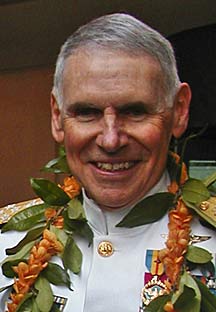Pacific
commander
installed
Friendship, trust and cooperation in the Asia-Pacific region were emphasized by the incoming and outgoing leaders of the U.S. Pacific Command yesterday at Camp Smith.
![]()

![]()
Adm. William 'Fox' Fallon: He apologized to families in Japan after the sinking of the Ehime Maru
"I pledge to you a dedication to the task of enhancing stability and setting the conditions for a security environment in this region and throughout the world in which people can truly live in peace and confidence," Fallon said to an audience of several hundred Pacific Command employees and invited state, national and international dignitaries.
The Pacific Command coordinates all U.S. military forces in the Pacific and Indian Oceans, including two of the world's most serious potential flash points: the Korean peninsula and the Taiwan Strait.
Heavy rain fell before the ceremony in front of the Nimitz-MacArthur Pacific Command Center, but stopped before Air Force Gen. Richard Myers, chairman of the Joint Chiefs of Staff officiated over the transfer of command from Fargo to Fallon.
Fallon said his Irish ancestors, who also lived on a green island, thought of rain as a good omen. "So I was absolutely thrilled to wake up to the pitter-patter of rain this morning," he said.
Fallon, 60, had been commander of Navy Fleet Forces in Norfolk, Va., until Friday and also has served as vice chief of naval operations, the second highest Naval position in the Pentagon. The Senate approved his appointment Thursday.
In 2001, Fallon flew to Japan to apologize to the families of those killed aboard the Ehime Maru after the Japanese fishing school trawler sank off Oahu in a collision with the submarine USS Greeneville.
He also flew combat missions in Vietnam and commanded a carrier air wing in the Persian Gulf War of 1991.
President Bush's original choice to replace Fargo was Air Force Gen. Gregory Martin, who was forced to withdraw his nomination in December after Sen. John McCain criticized his ties to an Air Force official embroiled in a procurement scandal.
Yesterday, Myers praised Fallon for "a superb job" in his past commands and said, "He has the talent and the vision to lead PACOM through some pretty uncharted waters. He is exactly, I think, the right person to lead our forces in this theater at this time."
Myers also complemented Fargo's work, including coordination of a huge relief effort after the Dec. 26 tsunami in Asia.
"Hours after that hit, Tom and his group here at PACOM already had help on the way," Myers said. The command deployed "16,000 people, 27 ships, lots of aircraft and delivery, in the end, of about 2 million pounds of supplies and bringing hope to people whose lives had just been devastated.
"That was one of the most complex types of disasters you could be confronted with, but Tom and his team did a superb job and we thank you and your nation thanks you," Myers said.
Fargo, 56, said he is retiring here after 35 years in the Navy because Hawaii is "a place where people care a great deal about their fellow man." He praised his military mentors and peers, enlisted men and women who have worked under him, and military spouses and families for their part in making the U.S. armed forces so effective.
Fargo specifically thanked Hawaii Sens. Daniel Inouye and Daniel Akaka and Alaska Sen. Ted Stevens for their advice and counsel during his three years as head of the Pacific Command. And he recognized representatives of Asia and Pacific governments for "your dedication to peace and stability... in a transforming and growing region."
LEADERSHIP OF THE U.S.
The U.S. Pacific Command was established on Jan. 1, 1947. Until 1958, the commander-in-chief of the Pacific Command also headed the U.S. Pacific Fleet. Commanders were: |
[News] [Business] [Features] [Sports] [Editorial] [Do It Electric!]
[Classified Ads] [Search] [Subscribe] [Info] [Letter to Editor]
[Feedback]
